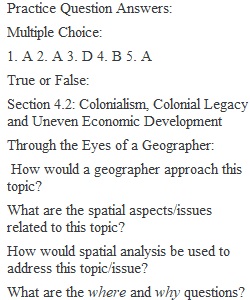


Q Section 4.2: Colonialism, Colonial Legacy and Uneven Economic Development Through the Eyes of a Geographer: How would a geographer approach this topic? What are the spatial aspects/issues related to this topic? How would spatial analysis be used to address this topic/issue? What are the where and why questions? How can this topic be studied and analyzed using the five themes of geography? Overview: The process of colonialism has occurred in virtually all regions of the world. Historically, certain world regions have been the dominant rulers (the colonizers) and other regions have been the vulnerable (the colonized). By 1918, a small number of western European countries had colonized 85% of the globe. The uneven structure of external rule and exploitation under colonialism has produced much of the global inequality that exists today among nations. Colonialism alters all components of culture including values, beliefs, language, religion, and food, as well as economic and political systems. Although the colonial era is officially over, wealthy countries still can exert control over poorer countries through a variety of means labeled as neo-colonialism or imperialism. Most of the dramatic changes that occurred under colonialism still exist today (such as non-indigenous beliefs, values, languages and political boundaries) and are part of what is known as the colonial legacy. Critical Thinking/Discussion Questions: 1. What is colonialism? Who benefits under this system? Who is disadvantaged under this system? 2. Where are the countries with lower levels of development, and why are they poor? What are some of the leading explanations for the uneven spatial distribution of wealth? 3. Officially, the colonialism era is over. Do wealthy countries today still exert their will over poorer countries? How is this accomplished? Practice Questions (Write Correct Answer in Blank): Multiple Choice: 1. ___ This European country had the greatest influence and number of colonies around the world: A) Britain B) Italy C) Portugal D) Spain 2. ___ Many of the problems developing countries experience today are a direct result of colonization. These problems of distorted national borders, education, and economies are part of the colonial ___: A) legacy B) gift C) agreement D) understanding 3. ___ Under colonialism, the relationship that exists between the mother country (colonizer) and the people being colonized is typically one of: A) equality B) gratitude C) simplicity D) exploitation 4. ___ Which of the following is NOT one of the explanations for the uneven distribution of wealth among countries of the world: A) cultural B) social C) environmental D) economic 5. ___ The process of European ___ was linked directly to the Industrial Revolution: A) colonization B) apartheid C) revolution D) exploration True or False: 1. ___ The political boundaries that exist in much of the world were drawn by European powers. 2. ___ It is very common for wealthy countries such as the U.S. to offer aid to other nations only if those nations accept certain conditions. 3. ___ Since the colonial era has ended there are no long lasting-effects on former colonies. 4. ___ Indigenous Africans greatly benefited from the education provided by the colonizing mother countries. 5. ___ The saying “The sun never sets on the British Empire” is a testament to the colonial prowess of Great Britain.
View Related Questions